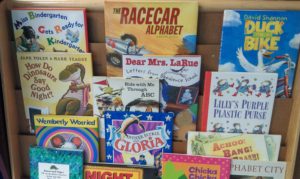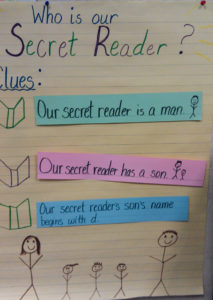One of the keys to success in reading instruction is helping students identify as readers and develop a positive disposition to reading. Research indicates that when students are in a calm, supportive, non-threatening environment where they can have meaningful, enjoyable interactions with texts, they are more likely to grow as readers.
I’ve worked with several students who have gone from resistant readers to highly engaged scholars, because they went from trying for a score to becoming readers. They discovered there were books they would enjoy (hooray!). Often, the biggest change came when they discovered a book they desperately wanted to read (often because a peer mentioned it), and it was a little too hard. Suddenly, they had a reading goal that was personally meaningful, and they were committed to the work.
Here are a few things that have helped my students identify as readers:
Set the Expectation
I call my students readers as often as I call them friends. When we gather at the carpet, I say, “Good morning, Readers!” I reinforce this identity as we continue through our time together. It’s simple and may or may not have anything to do with our success, but it sets the tone, helping students know immediately that I see us all as readers.
I also make it clear that I am not the only person who can talk with students about a book. I’m a reader, just like they are. Although I provide a lot of reading coaching, I work hard to create a reading community within our classroom. It’s important to me that students are sharing book recommendations and reading tips with each other as much as I am.
Set the Mood
We work together to decide what mood we want for our reading time. Generally, it’s quiet, with soft instrumental music playing in the background. Students typically find that silence is distracting, because it’s startling when someone sneezes or moves. We’ve also found that it can be troublesome if you feel you need to get a tissue or shift around in your spot when the classroom is completely silent, because you don’t want to disrupt other readers.
I also allow snacks and water during reading time, as long as book boxes and the classroom are kept tidy, and I keep a stash of snacks and breakfast foods for those who need them when the district permits it. Because we often have reading in the morning, students who haven’t had enough for breakfast can struggle if those basic needs are not met. (And more importantly, I want their basic needs to be met!)
I also have book recommendations out in the classroom, much like you would in a library. These are tailored to current student interests and seasons. In upper grades, this area is often managed by students, and it’s fun to see what texts they’re loving and sharing.

Read Aloud
I LOVE reading aloud to my students at all grade levels, and when I’m reading, I’m ALL IN. We get lost in the world of the book as much as possible as I use voices, volume, and intonation to help students engage with the text.
The First Read Aloud
My first read aloud is probably the most carefully chosen text of the year. After all, I’m setting the tone for our class reading time, and I want to be sure students know that reading time is the best time.
Early Childhood & Early Elementary
I choose a highly interactive picture book to share with primary students. Ideally, it’s one that will make them laugh. At this age, reading is an easy sell. If it’s fun, silly, or involves movement, you’ve generally got a winner on your hands.
Young children are naturally inclined to love read aloud time, especially if I use different voices for the characters. I read softly and lean toward the students, pausing dramatically for effect. Together, we lose ourselves in the world of the text, and when we emerge, we find our reading bond has begun to solidify.
Upper Elementary
In the upper grades, I think about the students who are most likely to be reading champions in my classroom. These are the students who enjoy reading and may even identify as readers already. I also think about the students who are resistant to reading and may have named it one of their least favorite subjects. I try to find a text both will enjoy.
On the first day of school, I often begin with a picture book. This is especially helpful when I haven’t had the opportunity to meet students yet. I may invite them to vote on which book to read or share a recent discovery that is a favorite of mine.
My students often help me choose the first chapter book of the year. I model Book Talks using a couple different books, and students vote to choose which one we should read. I try to choose something highly engaging and suspenseful with a fair amount of action and lots of dialogue. After all, character voices have a huge impact on the quality of the read aloud!
Secret Reader
It is SO much fun when we have parents and other special adults who are willing to come read to the class. I give students clues to figure out who our secret reader will be, and we have a blast guessing. It’s a great opportunity to see that we have lots of readers in our lives. Plus, I’ve discovered some really awesome books this way!

Provide Opportunities For Choice
My students choose almost everything about their reading.
I allow them to pick their own books for independent reading, and sometimes we even vote on which book we’ll use for guided reading. The only limits are that the book is Just Right for them and that the content is school appropriate.
Students also choose their own seats. I provide various seating options (rocking chair, bean bag chair, carpets, etc), and students are free to make their own decisions about what works best for them. Some of my students have loved sitting in the rocking chair or beanbag chair in the middle of the room, while others prefer to cozy up alone in a quiet corner.
Behavior & Management
Almost every year, I have a group of students who decide they’ll hide under their desks to avoid reading when we first get started. I give them one day to “secretly” pass notes and books around in silence, visiting occasionally to redirect (as I do with everyone) and carefully observing each individual.
At the end of reading time, we reflect on our work and make decisions about where we’ll sit the next day. I’m always interested to see who decides they’ll choose a different place to read the next day and helps me figure out where to start with our reading conferences. It also gives students the opportunity to take responsibility for their choices and helps build trust in our relationship, since I don’t say anything if they continue to choose better seats from then on.
On the second day, I bring my book to join them. I read silently for a couple minutes, which motivates them to do the same. Within 5-10 minutes, most students discover that they are actually rather uncomfortable there and ask to move. I allow it, and point out that this is not a problem that should occur again. Typically, the issue is not repeated, and the one student who finds they love reading under the desk enjoys the solitude.
Once everyone is settled, I move quickly into reading conferences with students who were distracted. If they were really enjoying their books, we wouldn’t have this problem, so it’s important to address the root of the issue as soon as possible.
Note: I have tried book conferences immediately to start by addressing the root of the issue, but it actually enhances the problem. Students need active supervision, coaching, and support when they are getting started in reading workshop. Otherwise, undesireable behaviors are quickly exacerbated.
Pair Every Reader With A Book They Love
This is one of my favorite parts of teaching reading! I can’t think of a single student I’ve had who wasn’t a reader when they left my classroom. However, I’ve had lots of students who believed they weren’t readers when we met. Every time, the issue was not the student – it was the books they were reading!
I encourage my students to abandon books that aren’t right for them. There are too many excellent books in the world to spend time reading the ones we don’t enjoy. The key is to figure out what you don’t like about the book before you return it. If you don’t, you may find yourself in exactly the same situation with the next book you pick.
I am highly involved in the book selection process, especially at the beginning of the year. I ask lots of questions to help understand each reader and follow up with them when they try a new book. As I get to know each child, I connect them with other readers who have common interests, and soon students are recommending books to each other!
Here are a few questions I’ve found helpful in finding the right book for each student:
- Have you ever read a book you loved? Tell me about it.
- What books have you tried that you absolutely hated? Why did you dislike them?
- Do you like books with more text or pictures?
- What is your favorite movie?
- Do you prefer to learn from your books or read a story?
- Have you tried (genre)? What did you think?
- Are you more interested in fiction or nonfiction?
- What would you guess might be fun to read about?
- Do you like books that are serious, funny, gross, informative, or something else?
Workshop Model
The workshop model is absolutely my favorite way to teach. I find that anything else eats up our precious reading and conferencing time, and that’s a serious problem for me. My students are the most successful when I can give them dedicated reading time each day and short, frequent (weekly or bi-weekly) reading conferences that are tailored to their individual reading needs, in addition to mini lessons and guided reading.
Mini Lesson
At the start of the year, I often teach this mini lesson to begin the process. I find it helps students know what to expect during our reading time. Students who love reading can feel confident in knowing that they have found a kindred spirit, and those who are unsure know that they have entered a place where reading is valued. I find that it fosters curiosity from those who have not enjoyed reading and excitement for those who have.
References:
Duke, Nell K (3 June 2016). What Doesn’t Work: Literacy Practices We Should Abandon. Retrieved from https://www.edutopia.org/blog/literacy-practices-we-should-abandon-nell-k-duke?fbclid=IwAR0gFBtymZ5AUVyGd6gthlvYluAELWBSF2R99u9DUzYOQFLZe66bA8wW_68
Katz, Lilian (1993). Dispositions as Educational Goals. ERIC Digest. Retrieved from http://ericae.net/edo/ED363454.htm
NAEYC (last updated 11 Dec 2018). Why Children’s Dispositions Should Matter to All Teachers. Retrieved from https://eclkc.ohs.acf.hhs.gov/school-readiness/article/why-childrens-dispositions-should-matter-all-teachers
Noyes, Debbie (N.D). Developing the Disposition to be a Reader: The Educator’s Role. Retrieved from http://citeseerx.ist.psu.edu/viewdoc/download?doi=10.1.1.543.1190&rep=rep1&type=pdf



